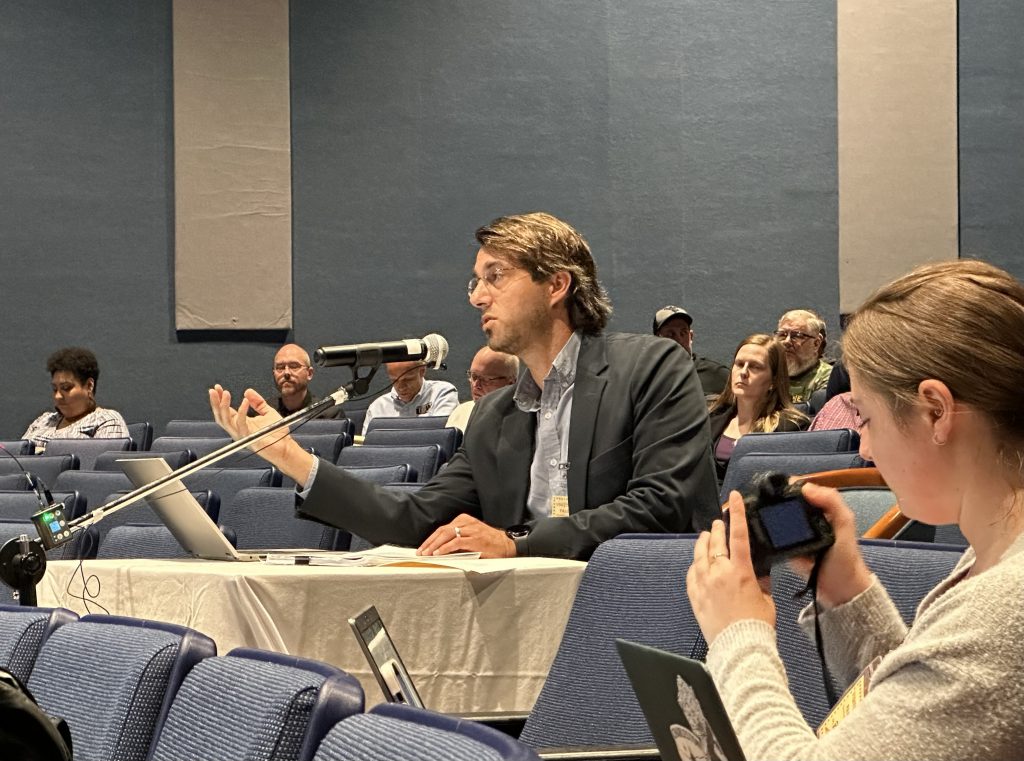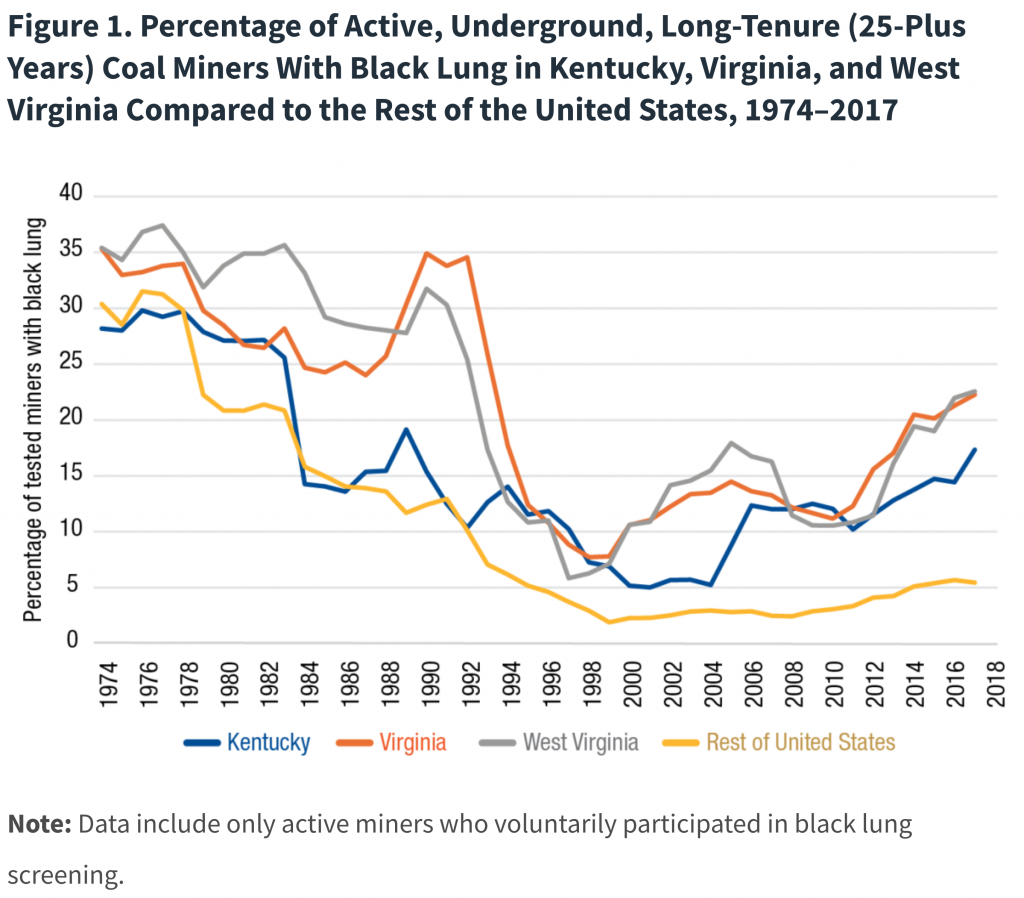Rule to protect miners from silica falls short

Sam Petsonk, an attorney who assists miners with black lung claims, spoke about the rule’s weaknesses at an in-person hearing held by the Mine Safety and Health Administration in Beckley, W.Va., in August 2023. Photo by J.M. Davidson
In April, the Mine Safety and Health Administration announced the final version of a rule meant to protect coal miners from respirable silica. The announcement was a long time coming. This deadly dust has been a major driver of the rise in black lung disease over the last two decades, and advocates for miners like the Appalachian Citizens’ Law Center have been pushing for such a rule since 2009.
MSHA released a draft of the rule last summer for public comment. Appalachian Voices, the National Black Lung Association and other advocates provided written and oral comments about their concerns on the rule, primarily focused on the lack of penalties for coal companies and an overreliance on mine operators to do the sampling themselves. Advocates, including us, argued that stricter penalties and independent oversight would save more lives.
Since then, we’ve been waiting to see how MSHA would incorporate our recommendations and concerns. Now that we’ve seen it, we and other advocates believe the final rule is a step forward but is overall a missed opportunity to truly address the rise in black lung disease. We’ll go through the deficiencies we’ve identified, but first, let’s take a step back and look at why lowering silica is important for protecting coal miners from black lung disease.
How did we get here?
Black lung disease, or coal worker’s pneumoconiosis, is an incurable occupational illness that is completely preventable. Coal miners become sick with black lung by breathing in coal and rock dust. In the mid-1900s, coal miners and advocates fought to bring attention to the issue that was impacting families throughout the coalfields. This activism in part helped bring about the passage of the Coal Mine Health and Safety Act in 1969, which established the black lung benefits system and put in place safety and inspection standards for mines to ensure workers aren’t exposed to dangerous work conditions and dust levels.
It took time, but following the 1969 Coal Act and subsequent legislation, black lung rates eventually began to decrease in Central Appalachia (Kentucky, Virginia and West Virginia) and the rest of the United States. Unfortunately, over the last two decades, that downward trend has reversed, and now black lung rates in Central Appalachia are back to what they were in the early 1990s.

Aysha Bodenhamer, https://carsey.unh.edu/publication/black-lung-Central-Appalachia
A significant driver for the rise in black lung has been the increased presence of silica dust during the mining process. In Central Appalachia particularly, as coal reserves have been mined out, coal miners have to dig and cut through more rock, which produces more silica dust. This dust is 20 times more toxic than coal dust. Now, coal miners are getting black lung earlier in their careers than in the past. Black lung clinics in Appalachia have seen miners diagnosed with complicated black lung in their 30s and 40s, and as many as one in five tenured miners has been diagnosed with some form of the disease.
It’s long been known that silica exposure is extremely dangerous. The National Institute for Occupational Safety and Health first recommended a 50 microgram silica exposure limit back in the 1970s. Mining is the only occupation where workers are allowed to be exposed to silica at 100 micrograms per cubic meter of air — all other occupations are governed by the Occupational Safety and Health Administration, which set the standard at 50 micrograms in 2016.
The final rule announced by MSHA in April lowers the silica exposure limit for miners. For the first time, it will create a separately enforceable standard, meaning that MSHA can require silica sampling and take action when silica levels are too high. But the rule has weaknesses that could allow operators to skirt the new limits

National Black Lung Association President Gary Hairston spoke about his experience living with black lung disease at the Beckley hearing. Photo by J.M. Davidson
Where’s the rule weakest?
A primary concern we had when the draft rule was released last summer was that no penalties or fines were explicitly enumerated. The final rule still contains this lack of clarity. It is at MSHA’s discretion when and how to penalize a coal operator who exposes their miners to silica dust. That means MSHA could penalize the company after the 10th violation, the 50th, or never. This lack of certainty exposes coal miners to unnecessary risks. They deserve to know that operators face penalties for not complying with the law.
Another concern echoed by advocates over the last year is that the rule allows coal operators to rely on miners’ personal use of respirators while dust levels are known to be high. The final version of the rule still allows coal to be mined while operators take corrective action to fix whatever has caused dust levels to be high. This puts the onus on miners to protect themselves with cumbersome respirators, rather than on the coal company to provide a healthy working environment.
This is predicated, of course, on sampling that could identify when silica levels are actually high. The final rule makes an improvement from the draft that requires operators to do more sampling under certain conditions, such as when there is a change of production or in geological conditions. But as history shows, coal companies have been known to cheat dust samples, as speakers at a hearing on the draft rule last summer pointed out.
Finally, it’s troubling that MSHA predicts this rule will only save 85 coal miners’ lives from deaths by black lung caused by high silica exposure. According to MSHA, 1,000 coal miners die every year from black lung disease. As the Appalachian Citizens’ Law Center notes, “[m]iners deserved a rule that would have maximized the prevention of disease and death, and we’re saddened this opportunity was missed.”
Even with the deficiencies, the rule does include positive advances like having a separately enforceable standard for silica dust. However, these advances will mean nothing if operators don’t follow the rule and if MSHA doesn’t have the resources to enforce it.
Congress has underfunded MSHA in recent years, and it takes time to train inspectors tasked with overseeing the safety of coal mines. That’s why it’s important that for the upcoming fiscal year 2025 budget negotiations, Congress fully fund MSHA’s budget request. A lack of adequate funding will reduce the possibility that this rule will protect coal miners from the scourge of black lung disease.
The post Rule to protect miners from silica falls short appeared first on Appalachian Voices.
Protecting the Central and Southern Appalachian Mountain Region
Source: https://appvoices.org/2024/05/02/silica-rule-2/
Anyone can join.
Anyone can contribute.
Anyone can become informed about their world.
"United We Stand" Click Here To Create Your Personal Citizen Journalist Account Today, Be Sure To Invite Your Friends.
Please Help Support BeforeitsNews by trying our Natural Health Products below!
Order by Phone at 888-809-8385 or online at https://mitocopper.com M - F 9am to 5pm EST
Order by Phone at 866-388-7003 or online at https://www.herbanomic.com M - F 9am to 5pm EST
Order by Phone at 866-388-7003 or online at https://www.herbanomics.com M - F 9am to 5pm EST
Humic & Fulvic Trace Minerals Complex - Nature's most important supplement! Vivid Dreams again!
HNEX HydroNano EXtracellular Water - Improve immune system health and reduce inflammation.
Ultimate Clinical Potency Curcumin - Natural pain relief, reduce inflammation and so much more.
MitoCopper - Bioavailable Copper destroys pathogens and gives you more energy. (See Blood Video)
Oxy Powder - Natural Colon Cleanser! Cleans out toxic buildup with oxygen!
Nascent Iodine - Promotes detoxification, mental focus and thyroid health.
Smart Meter Cover - Reduces Smart Meter radiation by 96%! (See Video).





